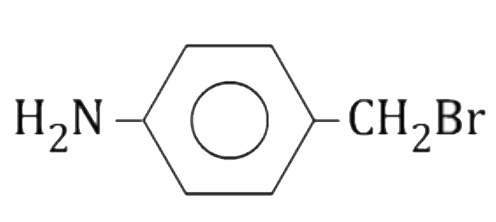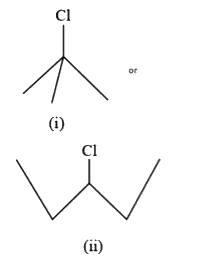Which one of the following compounds undergoes predominantly S2N reaction with aqueous NaOH in a polar aprotic solvent ?




The correct Answer is:B
To determine which compound undergoes predominantly an S2N reaction with aqueous NaOH in a polar aprotic solvent, we need to analyze the electrophilicity of the carbon atom bonded to the leaving group in each compound. The S2N mechanism involves a nucleophile attacking the electrophilic carbon, leading to the formation of a transition state and ultimately resulting in the substitution of the leaving group.
1. Identify the Compounds: We have four compounds to analyze. Let's denote them as:
- Compound 1: Methoxybenzene (C6H5OCH3)
- Compound 2: Nitrobenzene (C6H5NO2)
- Compound 3: Benzyl bromide (C6H5CH2Br)
- Compound 4: Aniline (C6H5NH2)
2. Understand the S2N Mechanism: The S2N reaction requires a good electrophile (carbon attached to a good leaving group) and a strong nucleophile. The rate of the reaction is influenced by the electrophilicity of the carbon atom bonded to the leaving group.
3. Evaluate the Electrophilicity of Each Compound:
- Compound 1 (Methoxybenzene): The methoxy group is an electron-donating group (+R effect), which increases electron density on the benzene ring. This decreases the electrophilicity of the carbon attached to the leaving group, making it less favorable for S2N.
- Compound 2 (Nitrobenzene): The nitro group is an electron-withdrawing group (-R effect), which decreases electron density on the benzene ring, increasing the electrophilicity of the carbon attached to the leaving group. This makes it more favorable for S2N reactions.
- Compound 3 (Benzyl bromide): The benzyl group can stabilize the transition state through resonance, but the carbon is not as electrophilic as in nitrobenzene. However, bromine is a good leaving group, which is favorable for S2N.
- Compound 4 (Aniline): The amino group is also an electron-donating group (+R effect), which increases electron density on the benzene ring and decreases the electrophilicity of the carbon attached to the leaving group.
4. Rank the Compounds Based on Electrophilicity:
- Nitrobenzene (Compound 2) has the highest electrophilicity due to the electron-withdrawing nitro group.
- Benzyl bromide (Compound 3) is next due to the good leaving group (Br) and some resonance stabilization.
- Methoxybenzene (Compound 1) and Aniline (Compound 4) are less favorable due to their electron-donating effects.
5. Conclusion: The compound that undergoes predominantly S2N reaction with aqueous NaOH in a polar aprotic solvent is Compound 2 (Nitrobenzene).
Final Answer:
Compound 2 (Nitrobenzene) undergoes predominantly S2N reaction with aqueous NaOH in a polar aprotic solvent.
- Compound 1: Methoxybenzene (C6H5OCH3)
- Compound 2: Nitrobenzene (C6H5NO2)
- Compound 3: Benzyl bromide (C6H5CH2Br)
- Compound 4: Aniline (C6H5NH2)
- Compound 1 (Methoxybenzene): The methoxy group is an electron-donating group (+R effect), which increases electron density on the benzene ring. This decreases the electrophilicity of the carbon attached to the leaving group, making it less favorable for S2N.
- Compound 2 (Nitrobenzene): The nitro group is an electron-withdrawing group (-R effect), which decreases electron density on the benzene ring, increasing the electrophilicity of the carbon attached to the leaving group. This makes it more favorable for S2N reactions.
- Compound 3 (Benzyl bromide): The benzyl group can stabilize the transition state through resonance, but the carbon is not as electrophilic as in nitrobenzene. However, bromine is a good leaving group, which is favorable for S2N.
- Compound 4 (Aniline): The amino group is also an electron-donating group (+R effect), which increases electron density on the benzene ring and decreases the electrophilicity of the carbon attached to the leaving group.
- Nitrobenzene (Compound 2) has the highest electrophilicity due to the electron-withdrawing nitro group.
- Benzyl bromide (Compound 3) is next due to the good leaving group (Br) and some resonance stabilization.
- Methoxybenzene (Compound 1) and Aniline (Compound 4) are less favorable due to their electron-donating effects.
Compound 2 (Nitrobenzene) undergoes predominantly S2N reaction with aqueous NaOH in a polar aprotic solvent.
Topper's Solved these Questions
Similar Questions
Knowledge Check
Which one of the following compounds undergoes predominantly SN2 reaction with aqueous NaOH in polar aerotic solvent?
A B
B C
C D
D
Which of the following compound is/are predominantly ionic?
AKClBNa2SCH2DCaOWhich one of the following compounds is most reactive for SN2Ar reaction
A B
B C
C D
D
Which one of following compounds undergoes EI reaction most readily?
View SolutionAmong the following, the compound that undergoes the fastest SN1 reaction is:
View SolutionWhich of the following compounds (s) undergo disproportionation in aqueous solution ?
View SolutionWhich of the following halide undergoes in hydrolysis via SN1 reaction?
View SolutionWhich one of the following two substances undergoes SN1 reaction faster ?

View Solution

